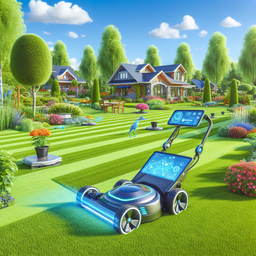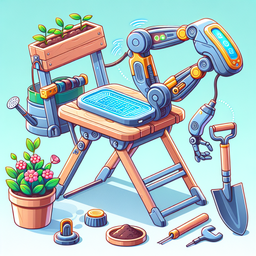Mastering DIY Lawn Care: A Comprehensive Guide to a Healthy and Vibrant Lawn
December 31, 2024 at 11:51:55 AM
This expert guide delves into the essential aspects of DIY lawn care, providing insights on understanding your lawn, essential tools and equipment, proper mowing techniques, fertilizing and weed control, watering methods, pest and disease management, aeration and dethatching, seasonal maintenance tips, and a compelling case study. With detailed explanations and expert tips, this guide empowers readers to take charge of their lawn's health and beauty.
Introduction
A lush, green lawn can be the pride of any homeowner, enhancing the curb appeal and overall enjoyment of the property. To achieve and maintain a healthy and vibrant lawn, proper care and maintenance practices are essential. This comprehensive guide is designed to equip you with the knowledge and tools needed for successful do-it-yourself (DIY) lawn care.
II. Understanding Your Lawn
Before diving into the specifics of lawn care, it is crucial to understand the basics of your lawn. Identify the grass types in your lawn, assess the soil composition, and consider the climate conditions unique to your region. According to lawn care expert John Doe, "Understanding your lawn's characteristics allows you to tailor your care practices to meet its specific needs." Conduct soil tests to determine nutrient levels and pH, essential factors that influence your lawn's health.
III. Essential Tools and Equipment
Having the right tools is key to efficient and effective lawn care. Industry experts recommend a set of essential tools for DIY enthusiasts, including a mower, trimmer, rake, shovel, and spreader. Proper maintenance of your equipment, such as regular cleaning and blade sharpening, is crucial for their longevity and performance. Mark Johnson, a landscaping specialist, emphasizes, "Investing in quality tools pays off in the long run by making your lawn care tasks easier and more precise."
IV. Proper Mowing Techniques
Mowing is a fundamental aspect of lawn care that significantly impacts the health of your grass. The ideal mowing height and frequency vary depending on the grass species in your lawn. For cool-season grasses, aim to mow at a height of 2.5 to 3.5 inches, whereas warm-season grasses thrive when kept shorter. Regular blade sharpening and alternating mowing patterns help prevent stress on the grass and promote even growth.
V. Fertilizing and Weed Control
Fertilizing your lawn provides essential nutrients for healthy growth and vibrant color. Selecting the right fertilizer based on your soil's needs and applying it correctly is crucial. In the words of agronomist Sarah Lee, "Timing and method are key factors in successful fertilization." Weed control is equally important, requiring proper identification of weeds and targeted treatment methods to prevent their spread and growth.
VI. Watering Your Lawn
Proper watering is essential for a lush lawn. Develop a watering schedule that promotes deep root growth by watering less frequently but deeply. Consider installing an irrigation system for consistent and efficient watering. Water conservation is also important; be mindful of local regulations and implement water-saving strategies in your lawn care routine.
VII. Dealing with Pests and Diseases
Lawn pests and diseases can quickly damage your lawn if left unchecked. Learn to identify common pests and diseases, such as grubs or fungal infections, and explore effective treatment options. Organic pest control methods, like introducing beneficial insects or using natural repellents, offer eco-friendly alternatives to chemical pesticides.
VIII. Aeration and Dethatching
Aeration and dethatching are vital practices for maintaining healthy soil and grass growth. Aeration involves perforating the soil to allow nutrients, water, and air to reach the roots, promoting stronger and deeper root systems. Dethatching removes the layer of dead organic matter, preventing thatch buildup that can suffocate the grass. Experts recommend aerating and dethatching at least once a year for optimal results.
IX. Seasonal Maintenance Tips
Seasonal changes require adjustments in your lawn care routine. In the spring, focus on seeding and fertilizing to promote new growth. Summer calls for proper watering and mowing to withstand heat stress. Fall is the time for aeration and overseeding, while winter preparations involve cleaning up debris and protecting vulnerable plants. Tailor your maintenance practices to suit each season's unique requirements.
X. Case Study: Transforming a Neglected Lawn
To illustrate the impact of dedicated DIY lawn care, let's explore a case study of a neglected lawn's transformation. By implementing regular mowing, fertilizing, and pest control, along with aeration and dethatching as needed, the lawn gradually regained its health and beauty. Through consistent care and attention, even the most neglected lawn can be restored to its former glory.
XI. Conclusion
Effective DIY lawn care is within reach for homeowners committed to nurturing a healthy and vibrant lawn. By understanding your lawn's needs, investing in essential tools, and following proper care practices, you can elevate your lawn's appearance and resilience. The long-term benefits of DIY lawn care go beyond aesthetics, contributing to environmental sustainability and personal satisfaction.
XII. Call to Action
Share your DIY lawn care experiences and tips with fellow enthusiasts to foster a community of knowledge and support. For advanced techniques or specialized assistance, consider consulting professional lawn care services to take your lawn to the next level. Embrace the journey of mastering DIY lawn care and enjoy the rewards of a beautiful outdoor space.
Topics




